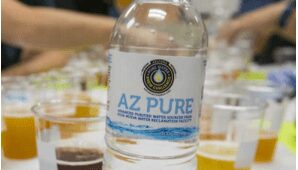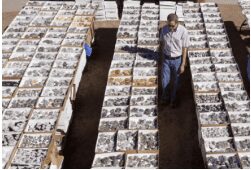1. SRP Hosts Water Conservation Expo. Salt River Project is hosting a water conservation expo on March 3, 2018 from 8:00 a.m. to 1 p.m. at the SRP PERA Club, located at 1 E. Continental Drive, Tempe.
You will need to register to attend at srpnet.com/expo or call 602-236-3333
* learn how to save water and money.
- get advice from landscape professionals
- find out about water conservation products and rebate programs
- meet Dave the Garden Guy and learn about low-water use landscaping

2. Free Green-Living Class: Vegetble Gardening In The low Desert. February 3, from 10 a.m. to noon. This class will be held at the Glendale main library, located on Brown Street (and 59th Avenue). Register at greenliving@glendaleaz.com or call 623-930- 3760.
3. FEBRUARY 14 LUNCH AND LEARN: WHERE WOULD WE BE WITHOUT WATER?
- When:02/14/2018 11:30 AM – 1:30 PM
- Location: 1720 E Camelback Rd Phoenix, AZ 85016

Registration
- Arizona Sustainability Alliance and their Guest – $25.00
- Comp Presenter • Green Living and their Guest – $25.00
- Member and their Guest – $25.00
- Non-Member and their Guest – $35.00
WHERE WOULD WE BE WITHOUT WATER?
Arizona’s economy and our lifestyle here in Arizona depend on a stable water supply.
Water policy in the face of Arizona’s 18 year drought is the most pressing issue facing the Arizona legislature this session and the biggest challenge we, as Arizonan’s face. Arizona gets 40 percent of its water from the Colorado River and a declining Lake Mead puts Arizona’s most precious natural resource at peril. Chris Kuzdas, agricultural water project manager for the Environmental Defense Fund, Jim Buster, Arizona Green Chamber’s Public Policy Chair, and Nicole Gonzalez Patterson, policy director of Business for Water Stewardship will discuss what we can do to meet the challenges that lie ahead.
Join us at the Blue Water Grill, 1720 E Camelback Rd Phoenix, AZ 85016, to hear from these leaders in water policy discussions:
4. OCWC General Members Meeting
Please, join us for Oak Creek Watershed Council’s General Members Meeting
February 2, 2018
9:30 a.m. – 11:30 a.m.
RED ROCK STATE PARK, Hummingbird Room
Meeting Agenda:
9:30 Welcome and Introductions … James Meza, Board Vice-Chair
9:35 Round Table Status Reports CONTINUED ON PAGE 3
10:00 Results and discussion of December’s participatory exercise on 2018 Activity Priorities
10:15 Short break
10:25 “Fine Sediment Deposition Impacts on Aquatic Macroinvertebrates in Middle Oak Creek . Presentation by Dr. Larry Stevens, Springs Stewardship Institute
11:25 New Business – next meeting in April 13, 2018 from 9:30 am – 11:30 am, at Red Rock State Park, Hummingbird Room. Please, note: For the remainder of 2018 we will be meeting according to our typical second Friday of the month schedule.
11:30 Adjourn
5. Parts Per Billion. In science and engineering, the parts-per notation is a set of pseudounits to describe small values of miscellaneous dimensionless quantities, e.g. mole fraction or mass fraction. Since these fractions are quantity-per-quantity measures, they are pure numbers with no associated units of measurement. Commonly used are ppm(parts-per-million, 10−6 ), ppb (parts-per-billion, 10−9 ), ppt (parts-pertrillion, 10−12) and ppq (parts-per-quadrillion, 10−15).
These numbers are so small, it is difficult to put it into perspective. So, consider these:
One minute in 2000 years
One heartbeat in 36 years
One thin mint in 25,000,000 boxes of Girl Scout cookies
One inch in 16,000 miles
One dimple on 2,600,000 golf balls
One M&M in 1,000tons of M&M’s
One sheet in 69,000 of toilet paper
One shot of vermouth in 7,500,000 gallons of gin (a VERY dry martini)
6. Recycled Water Use Gaining Acceptance. by Sam Potteiger, WRRC Student Research Assistant
In the Southwest, where water scarcity is an issue, water reclamation has been adopted as an important conservation strategy. Most of the water used at the Palo Verde Nuclear Generating Station near Tonopah is recycled wastewater from Phoenix. The plant is responsible for supplying power to residents throughout New Mexico, Texas, California, and Arizona. The Desert Mountain Club in Scottsdale uses reclaimed water to irrigate its 550 acres of turf, which accommodate 150,000 rounds of golf each year. The club uses one billion gallons of treated wastewater each year, making it the largest user of reclaimed water in the metro Phoenix-Scottsdale area. In Pima County, reclaimed water is used mainly for irrigating parks and outdoor landscaping. According to its website, the City of Tucson serves reclaimed water to 50 parks, 18 golf courses, and more than 700 single-family households.
The resistance to and acceptance of reclaimed water use by citizens has important implications for utilizing recycled water as a resource. A 2015 study published in the journal Judgment and Decision Making analyzed the attitudes of respondents to the use of potable recycled water in five different metropolitan areas–three in water-scarce regions. Nearly 50 percent of respondents stated that they would be willing to drink recycled water; however, the other 50 percent of respondents were not as confident. They responded that they might try it or would not try it at all. Across the five metropolitan areas, people were more receptive to the use of recycled water for purposes other than drinking. Although there exists a population who support the use of recycled water, a significant number of people still oppose it.
Investigators have tried to identify the cause of public uneasiness regarding potable recycled water, as well as what motivates people to use it. One factor, awareness of water scarcity, appears to affect people’s attitudes. The year 2016 saw one of the worst droughts California has experienced. A poll conducted in California that year by water technology firm Xylem found that 89 percent of respondents agreed that the threat of drought had made them more supportive of recycled water use.

Another major factor is level of relevant knowledge and awareness. A 2011 study in Water Resources concluded that knowledge about water sources, including reclaimed water, was linked with positive perceptions and the likelihood that the water would be used. In the Xylem poll, 89 percent of respondents were more willing to use recycled water for general purposes after they heard about the treatment process. The results from these studies send a clear message to proponents of recycled water about the importance of outreach and education to securing public support. This past summer, Arizona Pure Water Brew set out to inform and engage the public about recycling water for potable use. Arizona Pure Water Brew was a statewide campaign to inform Arizonans about water issues, water reuse, and the water purification technology. In August 2017, the campaign challenged brewers with a competition for the best beer brewed using purified wastewater. Twenty-six brewers took up the challenge.
To reach Arizonans, all of the water treatment equipment was contained in a truck that traveled around the state and supplied brewers with purified water created by treating local wastewater. The side of the truck could be opened to demonstrate the purification system inside. Purification involved a five step process, which resulted in treated wastewater that was purer than water from the tap. The purified water was then distributed to the competing brewers at each location.
The brews were indistinguishable from brews using regular non-recycled water. In a blind taste test, panelists were not able to discern a difference in taste. In addition, brewers found the recycled water easier to use because they did not have to remove any minerals in order to make the water suitable for brewing. The winners were announced at the 32nd Annual WateReuse Symposium in Phoenix in September. The Arizona Pure
Water Brew project was all about conservation and education. They wanted to take their point to the people, and what’s more relatable than beer? Their outreach effort was especially timely, as it coincided with deliberations leading to changes in Arizona’s recycled water regulations.
The Arizona Department of Environmental Quality (ADEQ) is the agency charged with the regulation of recycled water. Under past regulation, reclaimed water could not be permitted for human consumption. It was mainly used for irrigation. Under modifications made effective January 1, 2018, this restriction was removed. However, in order for wastewater to be used for potable water purposes it would have to undergo further treatment at a specified “advanced water treatment facility”. The advanced water treatment facility would be permitted only after demonstrating that it could meet stringent standards. According to ADEQ, a permitted facility would be capable of removing 99.99999999 percent of all viral contaminants. For comparison, under the Safe Drinking Water Act, surface water sources must remove 99.99 percent of all viruses. Thus, under the regulatory modification, potable water from a reclaimed source would have to be orders of magnitude cleaner than any existing surface water source.
The use of reclaimed water can be expected to expand as growth and other factors increase the demands on existing water supplies. Purified wastewater will be used by some communities to augment their potable supplies. With proper oversight, water reclamation can be an effective solution to water scarcity issues in Arizona and throughout the Southwest.
7. Tuscon’s Annual Gem Show Begins Saturday. The Tucson Gem, Mineral & Fossil Showcase begins Saturday, Jan. 27, and continues through Sunday, Feb. 11. During that time, visitors and residents come to hunt for jewelry, jewelry-making supplies, bargain priced collectibles, and rare treasures. Shows take place at dozens of locations throughout the Tucson area. Most shows are open to the public with free admission. The showcase concludes with the 64th annual Tucson Gem and Mineral Show at the Tucson Convention Center, Feb. 8-11. The Official Tucson Gem Show Guide app provides show locations, hours of operation, transportation options, and a guide to local dining. Park Tucson offers GemRide, a free shuttle service that connects convenient parking locations with most of the shows.

Visit Tucson event listing: http://bit.ly/2jVS8it
Official Gem Show Guide app: http://bit.ly/2E6IUtQ Park Tucson Gem Show Parking and Free GemRide Shuttle: http://1.usa.gov/1UDitx9
Tucson Gem and Mineral Show: http://bit.ly/2FasAHP
8. Fish That Clean Phoenix’s Canals Are Gorging Themselves Officials say the fish they use to help clear algae and weeds from Phoenix canals are overeating and getting even bigger.
Fish that primarily feed on algae and weeds in canals that deliver water to the Phoenix area are overeating and getting even bigger.
The Salt River Project made the discovery as crews move fish to different parts of the canal system for maintenance. The white amur fish that typically measure around 30 inches (76 centimeters) are up to 15 inches (38 centimeters) longer, said SRP spokesman Jeff Lane.
The Salt River Project has been using the sterile fish native to China to help clear the canals since 1989 and avoid treating the water with chemicals, The Arizona Republic reported . The largest of them were found near Mesa’s Granite Reef Diversion Dam, an area thick with vegetation.
The utility looks for a certain type of fish for clearing canals — ones with heads big enough that they cannot wiggle through grates. Wide-headed fish also mean the grates can have fewer bars and allow water to flow through more freely, said Brian Moorhead, an environmental scientist and engineer with SRP.
While they’re coveted for the amount of vegetation they can eat — up to two-thirds of their body weight daily — the cold can halt the fish’s work.
Moorhead said the fish stop eating when the temperatures dip to 65 degrees, but vegetation has a lower threshold for growing at 60 degrees. “We want them to eat all the vegetation,” he said. The cleanup of the canal system is scheduled to run through Feb. 5.
